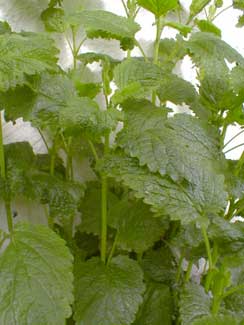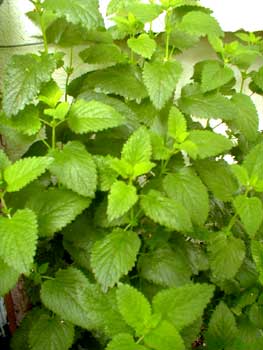
Lemon Balm
"I can easily imagine now that the sun has reached the edge of that rice-field, and the old fisher-woman is gathering herbs for her supper by the side of the pond."
-Rabindranath Tagore
(1861-1941)
(1861-1941)
Lemon balm; aka, Sweet Balm (Melissa officinalis) is a most pleasant herb for scent & beauty, but impossible to restrain. It has naturalized around the globe, & began its world-wide journey millennia ago, so that its origin is uncertain, though thought to have come from Western Asia.
It's usefulness as a spice & its medicinal properties meant it was early transported everywhere, & being more than commonly adaptable, it settled in to grow wherever it found itself. It is by now so long naturalized everywhere from southern Europe to northern Africa as to be regarded as native flora, & discovery of the New World brought it very soon to North America.
When we bought the house some years back, a huge patch of lemon balm beside the back stoop was just so gorgeous spring through autumn that I tolerated it, but having so much of it dying back in late autumn was just too homely to have right by the door, plus it was self-seeding all over the yard. When I dug out the mother-plant I was surprised that it had huge woody roots, up to three or four inches thick like the root of an old shrub.
 Years after I elected to get rid of it, it continues to spring up at will wherever it likes, & most of the time I pull it as a weed, sometimes I plant it in a pot for others who may like it. I've given up on the idea of ever really controlling it & instead adjust my mind to enjoying it on its own terms.
Years after I elected to get rid of it, it continues to spring up at will wherever it likes, & most of the time I pull it as a weed, sometimes I plant it in a pot for others who may like it. I've given up on the idea of ever really controlling it & instead adjust my mind to enjoying it on its own terms.As a garden ornamental it is liked for its redolent light green leaves & hardiness in near-droughty locations, though at high summer it can look very scruffy if not watered, dying back prematurely. Anytime it doesn't look up to snuff it can be trimmed practically to the ground to start afresh. It is hardy in zones 5 through 9, & can be grown down to Zone 3 with winter mulching.
Though it prefers a lot of sun with regular watering in rich well-draining soil, I've had it pop up in completely dry areas in fairly deep shade in poor soil -- & not as a stunty thing either, it is surprising where it can establish itself. A very old long-established clump is inevitably drought-hardy.
I periodically let some of it grow up big & bushy, especially if it self-seeded somewhere nothing else wanted to spread into. Thus I can enjoy it for its beauty & then harvest the leaves.
These will grow three feet tall & wide in a single year. In early to late summer they produce tiny white flowers too small to be significant but prettily dotting these minty subshrubs. The flowers are obviously more impressive to bees who adore Lemon Balm, for which reason its genus name, Melissa, means "bee." Its common names in many languages around the world allude either to its ability to attract bees, or to the lemony scent of the leaves.
As a medicinal herb, Lemon bBlm is thought to settle nerves when taken as a tea, & has very mildly antiviral qualities. It contains many flavorful volatile oils that make it excellent to cook with. It grows so rapidly you could harvest some leaves once a week & never run out until autumn frost stops it growing.
If used raw in salads or as garnish, the youngest palest leaves are best, but fried with, say, country fried potatoes & wild nettles, any unstemmed leaf is fine. The leaves can also be dried & retain a huge percentage of their flavor (though dried it smells more like sassafras), & used as a dried herb or to brew winter tea.
It can be mixed half-and-half with basil for a unique lemony pesto. Lemon Balm is also one of the ingredients of "Hessian Green Sauce" or Frankfurt Sauce.
By tradition Hessian or Frankfurt Green Sauce is a "seven herb" mixture, though depending on season the specific spices vary. Select seven in equal portions until you have three cups, fresh, of: lemon balm, salad burnet, parsley, chives, chervil, cress, sorrel. borrage, spinach, plantain, dandelion, dill, watercress, terragon or lovage. Mix with two hardboiled eggs, moisten well with vinegar & oil, salt & pepper, & purie in blender until it¼s the consistency of pesto or mayonnaise. Be creative in your herb choices, & experiment with a portion of the oil replaced with yogurt or sour cream or, for lowfat version, ricotta or cottage cheese. A small onion is optional.
You're bound to light upon a mix worth writing down & spreading throughout the family for generations to come. It's served over sundry dishes but especially over boiled potatoes, or carrots, or asparagus. Try it on mashed cauliflower-and-potatoes. Tradition required hard apple cider be imbibed with such a dish.
Lemon Balm is also used like spearmint leaves as a garnish to ice tea, or for fruit-cups. It can be used in any recipe that might otherwise call for lemongrass. It's a flavoring for icecream, candies, fish, poultry, often mixed with mint.
It is highly regarded as a folk remedy, it's species name meaning "medicine." As a tea it is generally thought of as a tonic & calmative. The leaves have some antibacterial & antioxidant action, same as with herbs of the Mentha genus such as spearmint, & like spearmint has been used as a mosquito repellant just by rubbing fresh leaves on exposed skin.
In the Elizabethan era, dandies & ladies would carry upon them a small bouquet called a Tussy Mussy, consisting greatly of Lemon balm, thyme, or oregano which could be held to one's nose while walking along sewage-ditched streets of London.
It likes rich moist soil, & may become spotty & unpleasant if left too dry, though it is suprising how harsh an area can be for its self-seeded offspring to do just swell. It accepts more shade than most herbs, & develops richer odor & flavor with partial rather than full sunlight. It contains a natural insecticide so is not much troubled by insects.